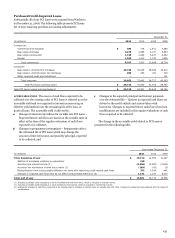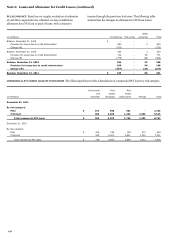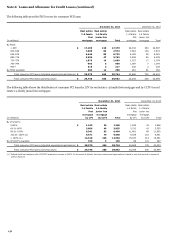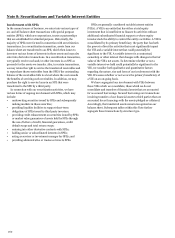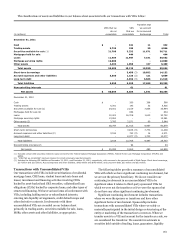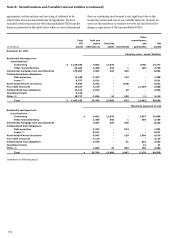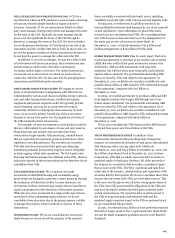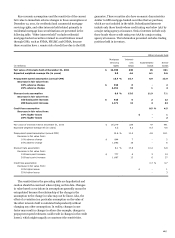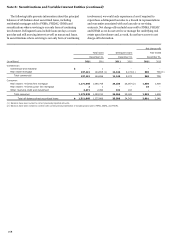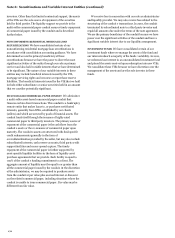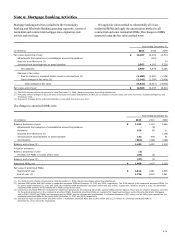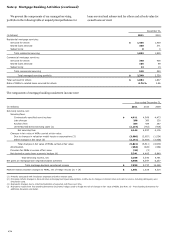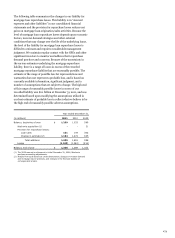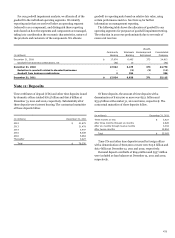Wells Fargo 2011 Annual Report Download - page 167
Download and view the complete annual report
Please find page 167 of the 2011 Wells Fargo annual report below. You can navigate through the pages in the report by either clicking on the pages listed below, or by using the keyword search tool below to find specific information within the annual report.COLLATERALIZED LOAN OBLIGATIONS (CLOs)
A CLO is a
securitization where an SPE purchases a pool of assets consisting
of loans and issues multiple tranches of equity or notes to
investors. Generally, CLOs are structured on behalf of a third
party asset manager that typically selects and manages the assets
for the term of the CLO. Typically, the asset manager has the
power over the significant decisions of the VIE through its
discretion to manage the assets of the CLO. We assess whether
we are the primary beneficiary of CLOs based on our role in the
transaction and the variable interests we hold. In most cases, we
are not the primary beneficiary of these transactions because we
do not have the power to manage the collateral in the VIE.
In addition to our role as arranger, we may have other forms
of involvement with these transactions. Such involvement may
include acting as underwriter, derivative counterparty,
secondary market maker or investor. For certain transactions,
we may also act as the servicer, for which we receive fees in
connection with that role. We also earn fees for arranging these
transactions and distributing the securities.
ASSET-BASED FINANCE STRUCTURES
We engage in various
forms of structured finance arrangements with VIEs that are
collateralized by various asset classes including energy contracts,
auto and other transportation leases, intellectual property,
equipment and general corporate credit. We typically provide
senior financing, and may act as an interest rate swap or
commodity derivative counterparty when necessary. In most
cases, we are not the primary beneficiary of these structures
because we do not have power over the significant activities of
the VIEs involved in these transactions.
For example, we have investments in asset-backed securities
that are collateralized by auto leases or loans and cash reserves.
These fixed-rate and variable-rate securities have been
structured as single-tranche, fully amortizing, unrated bonds
that are equivalent to investment-grade securities due to their
significant overcollateralization. The securities are issued by
VIEs that have been formed by third party auto financing
institutions primarily because they require a source of liquidity
to fund ongoing vehicle sales operations. The third party auto
financing institutions manage the collateral in the VIEs, which is
indicative of power in these transactions and we therefore do not
consolidate these VIEs.
TAX CREDIT STRUCTURES
We co-sponsor and make
investments in affordable housing and sustainable energy
projects that are designed to generate a return primarily through
the realization of federal tax credits. In some instances, our
investments in these structures may require that we fund future
capital commitments at the discretion of the project sponsors.
While the size of our investment in a single entity may at times
exceed 50% of the outstanding equity interests, we do not
consolidate these structures due to the project sponsor’s ability
to manage the projects, which is indicative of power in these
transactions.
INVESTMENT FUNDS
We do not consolidate the investment
funds because we do not absorb the majority of the expected
future variability associated with the funds’ assets, including
variability associated with credit, interest rate and liquidity risks.
During 2011, we redeemed a $1.4 billion interest in an
unconsolidated investment fund managed by one of our majority
owned subsidiaries. Upon redemption we placed the assets
received into new investment fund VIEs. We consolidated these
new VIEs because we have discretion over the management of
the assets and are the sole investor in these funds. At
December 31, 2010, we had investments of $1.4 billion and
lending arrangements of $14 million with this fund.
OTHER TRANSACTIONS WITH VIEs
In 2008, legacy Wachovia
reached an agreement to purchase at par auction rate securities
(ARS) that were sold to third-party investors by certain of its
subsidiaries. ARS are debt instruments with long-term
maturities, but which re-price more frequently, and preferred
equities with no maturity. We purchased all outstanding ARS
that were issued by VIEs and subject to the agreement. At
December 31, 2011, we held in our securities available-for-sale
portfolio $643 million of ARS issued by VIEs redeemed pursuant
to this agreement, compared with $1.6 billion at
December 31, 2010.
In 2009, we reached agreements to purchase additional ARS
from eligible investors who bought ARS through one of our
broker-dealer subsidiaries. We purchased all outstanding ARS
that were issued by VIEs and subject to the agreement. As of
December 31, 2011, we held in our securities available-for-sale
portfolio $624 million of ARS issued by VIEs redeemed pursuant
to this agreement, compared with $901 million at
December 31, 2010.
We do not consolidate the VIEs that issued the ARS because
we do not have power over the activities of the VIEs.
TRUST PREFERRED SECURITIES
In addition to the
involvements disclosed in the preceding table, through the
issuance of trust preferred securities we had junior subordinated
debt financing with a carrying value of $7.6 billion at
December 31, 2011, and $19.3 billion at December 31, 2010, and
$2.5 billion of preferred stock at December 31, 2011. In these
transactions, VIEs that we wholly own issue debt securities or
preferred equity to third party investors. All of the proceeds of
the issuance are invested in debt securities or preferred equity
that we issue to the VIEs. The VIEs’ operations and cash flows
relate only to the issuance, administration and repayment of the
securities held by third parties. We do not consolidate these VIEs
because the sole assets of the VIEs are receivables from us. This
is the case even though we own all of the voting equity shares of
the VIEs, have fully guaranteed the obligations of the VIEs and
may have the right to redeem the third party securities under
certain circumstances. We report the debt securities issued to
the VIEs as long-term junior subordinated debt and the
preferred equity securities issued to the VIEs as preferred stock
in our consolidated balance sheet.
In 2011, we redeemed $9.2 billion of trust preferred securities
that will no longer count as Tier 1 capital under the Dodd-Frank
Act and the Basel Committee guidelines known as the Basel III
standards.
165


